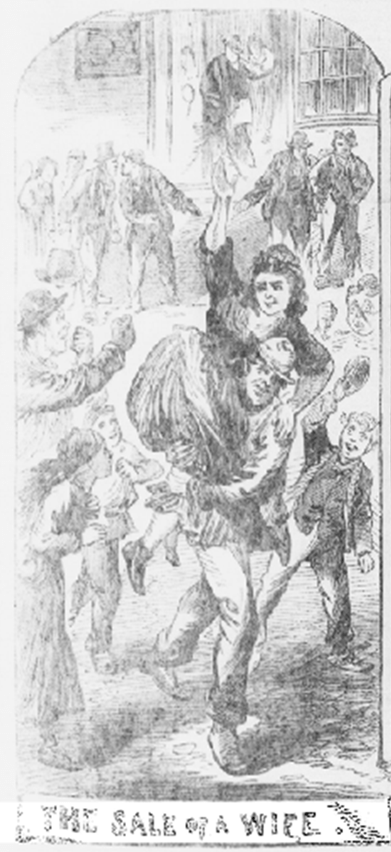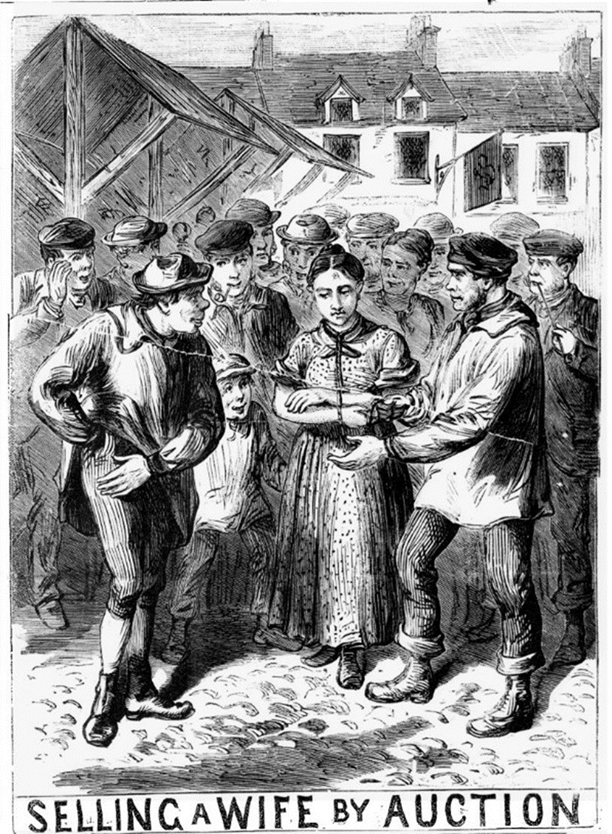Last year for International Women’s Day, our Assistant Collections Curator Lauren Padgett gave a popular and lively illustrated talk on wife-selling. This year, she has kindly shared her research as a blog focusing on wife-sales in Victorian Bradford.
So, without further ado, we will continue.
She writes:
A ‘British Institution’ or ‘British Scandal’?
Divorce as we know it was not permitted until the 1857 Matrimonial Causes Act which allowed newly formed civil Divorce Courts to litigate divorce cases. Before this Act, there were other legal and illegal methods of ending marriages – one was wife-selling.

The origins of this folk custom in Britain are debated. The first recorded case occurred in 1553 but it thought to be Anglo-Saxon in origin, practiced as early as the eleventh and twelfth century. Wife-selling was not just a method of ‘self-divorce’ but ‘self-marriage’ as the act of selling a wife ended the marriage between the wife and seller-husband and started a marriage between the wife and buyer-husband – although the legitimacy was arguable.
Wives could be sold by public auction in public places with mock and genuine bidders but usually a pre-determined buyer – the wife’s lover if there had been an affair. Public sales were transactions or agreements between the wife, seller-husband and buyer-husband in a public place to create witnesses. Private sales and agreements happened behind closed doors, sometimes with written contracts. Public auctions and sales were performative and ritualistic.
Often the wife was led to the sale location (usually a market place or public house) with a halter around her neck to resemble livestock, reminding people that wives were the property of husbands, on a par with cattle and chattel. A bellman might have announced the start of the auction and an auctioneer might have overseen it.
Wife-sales happened more often than not with the consent of the wife – another researcher found only four cases between 1760 and 1880 of wife-sales occurring without the wife’s consent. The price of wives varied from tokenistic amounts to legitimise the transaction to rarer high sums. Goods as well as money were exchanged. In Carlisle in 1832, a wife was sold for £1 and a Newfoundland dog. Some wives were exchanged for pints of beers. Despite the 1857 Act which was supposed to make divorce cheaper and accessible to the masses, this folk custom continued into the early 20th century, particularly in northern industrialised towns.
Bradford and its ‘brutal exhibitions of depravity’
Bradford Butter Market in 1837 was the scene of ‘one of those brutal exhibitions of depravity’. The reason behind the sale ‘was the incontinence of the wife, whose affections were stated to have been alienated by an old delver’. (A delver was a ditch or quarry worker). At the auction, with the husband acting as the auctioneer, ‘the first and only bona fide bid’ was by the delver for a sovereign ‘which was immediately accepted, and, the money being paid, the couple walked off amidst execrations of the crowd’.
The Leeds Mercury newspaper reported another ‘disgusting exhibition’ in Bradford, 1839 at Bradford market cross. The newspaper explained how William Farrar arrived at Bradford market cross at around four o’clock in the morning with his wife, a buyer called Green and a witness called Hainsworth. Farrar’s (nameless) wife was sold to Green for 5s. but 2s. 6d went to Hainsworth for his trouble of being a witness. The article stated that they had travelled from Stanningley, Leeds, to Bradford market cross ‘under the idea that the transfer would then be legal’ at that location.
A twice attempted Bradford wife-sale occurred in November 1858. Hartley Teasley (or Thomson) attempted to sell his wife, Martha. Two newspapers gave different accounts of the events surrounding the sales.
The Bradford Observer said that the husband and wife had
‘become mutually tired of each other . . . and mutually unfaithful to their marriage vows’.
A wife-sale was agreed.
‘This mode of severing the nuptial knot was decided upon’ as ‘divorce [was] a costly affair even under the new law’.
The wife was sold for 15s. on the evening of Saturday 20th November in a beer-house in the Shearbridge area of Bradford, but
‘it was afterwards discovered that some formality, considered essential, had been overlooked, and it was determined to have another sale on Monday’.
On the Monday morning, a bellman announced that the sale would that place that afternoon at the same beer-house. With‘the accessories not overlooked’ this time, Martha was led there by ‘halter decorated with red, white and blue streamers’ and ‘whip being duly prepared’. ‘Spectators were on the tiptoe of expectation’ at this ‘disgraceful and somewhat uncommon transaction’.
The nearby factory owner, outraged with the custom, declared that if any of his employees were involved they would be sacked. With this threat in place, the arranged buyer, Ike Duncan, tried to have a private agreement drawn up but failed, ‘and so the affair went off for that time’.

The Burnley Advertiser reported that
‘one ex-councillor of Horton offered 7s, 6d, and a bottle of brandy, but the husband refused to take less than 15s, and the woman refused to be sold to anyone but a favourite named “Ike”. Ike was not there to bid and so there was no sale’.
Martha, dissatisfied with still being married to her husband, lodged a complaint against him at the Borough Court on the Wednesday about his ‘long ill-usage’ and a warrant was ordered for his arrest.
The Illustrated Police News in an 1870 article about wife-sales referred to this particular wife-sale, quoting the Stamford Mercury, but the details differ to the Bradford Observer report.
Illustrated Police News named the husband as Hartley Thomson and does not mention of the attempted Sunday sale.
It described the wife as ‘a person of pre-possessing appearance’ and explained that the spouses had ‘not long wedded’ but ‘led a very unhappy life’. The reason of the failed Monday sale was due to the ‘disturbance . . . created by a crowd from a neighbouring factory, and that the person to whom it was intended to sell the wife was detained at his work beyond the time’.
On the surface it may seem shocking and scandalous by today’s standards, but these cases and others that I have researched seem to suggest that wife-selling was mostly consensual and offered some women a sense of agency. Rather than being trapped in unhappy marriages, unable to afford a divorce even through the post-1857 divorce courts, wife-sales allowed some women to escape unhappy marriages and move on with new husbands and (hopefully) better lives.